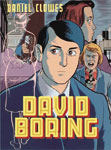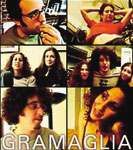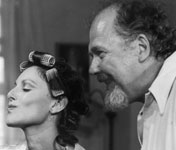THE SUPER 8
 |  |  |
| left to right: David Boring, a graphic novel by Daniel Clowes; Fuck Gramaglia Up by Andrew Gurland and Huck Botko; Gwen Wells with Robert Altman on the set of Nashville.
| ||
1. The Sample FAQ: Pitting technology against technology for only the most arcane and obsessive of purposes is this provocative hip-hop website. Armed by a cadre of vinyl junkies, the site tags samples found in popular hip-hop tracks with the usually uncredited creators of their original grunts, licks and cymbal crashes. Scroll through the madness at members.accessus.net/~xombi/intro.html.
2. David Boring: Daniel Clowes, the comix giant behind Ghost World (Crumb-director Terry Zwigoff’s new film, now in postproduction), wrote David Boring (Pantheon, $19.99) while he and Zwigoff were still shopping their funny/creepy teen flick around Hollywood.
Entertaining in inverse proportion to its hero’s moniker, Boring is the story of a blank-faced young man with an ass-fixation and an uncanny knack for defying death: twice during the novel, and to no particularly ill effect, David gets shot in the head. Built on an amalgam of plot mechanics from Vertigo and Lolita – with a dash of Superman’s hapless pal, Jimmy Olsen, thrown in – the book, Clowes says, is a meditation on comics, major motion pictures and the vagaries of divine power: "The one thing that comics have to offer that film doesn’t, is that comics allow you to play God much more directly."
3. Nashville. Made in 1975 and recently released on DVD (Paramount, $29.99) – the first time it’s ever been available for home viewing in its original widescreen format – Robert Altman’s vast canvas of political contempt and regional condescension is as much the embodiment of turbulent ’70s cinema as a snide bumper sticker from a bygone time: America, love-it-or-leave-it style. Dismiss the film’s hemp-basted Hollywood cynicism if you wish, but there’s no denying the very real Tennessee residents who populate the edges of the picture. And now you can actually see them again, freeze-frame them, study their sunburns and sideburns, their skeptical glances and homegrown disdain. Henry Gibson’s hairpiece is one thing, but these folks from Hickory Hollow and Murfreesboro Road – they’re the real McCoy. Hands down, the best performance by a thousand extras in all of the old New Hollywood.
4. Fuck Gramaglia Up. Screenwriter John Gramaglia confides in his friend Andrew Gurland a secret: he’s been lusting after his own girlfriend’s best friend, even going so far as to send her mash letters. So doc filmmaker Gurland (Frat House) and underground auteur Huck Botko visit both girls only to find that they’ve compared notes, are pissed and are planning to "fuck Gramaglia up." Botko turns on the camera as Gurland – whose upcoming New Line flick, Cheaters, details his high-school study methods – gets in the middle, manipulating and exploiting his (former?) friends to highly entertaining effect. The digital Web short is currently streaming on ifilm.com.
5. Echelon and Carnivore. A vast intelligence network is created that eavesdrops on virtually every telephone, cable and fax communication made in the world. Nation-states secretly band together to keep the network running, trading one another’s spy data in order to circumvent their own laws against wiretapping. And, increasingly, governments collude with big business by using this surveillance for corporate espionage, all under the redefined guise of "national security." The next William Gibson novel? No. Echelon, an automated global "interception and relay system" was begun in 1971 as a project of the American, Canadian, Australian, British and New Zealand governments, but recent technological innovations have expanded its power tremendously. It is now thought to intercept up to three billion messages a day, subjecting all of them to artificial-intelligence programs designed to flag a myriad of suspicious intents. And while
Echelon is run by the shadowy folks at the National Security Agency, the good old FBI has come up with Carnivore, a program – run on Windows, of course – that dials into Internet Service Providers and sifts through all their e-mail messages for similar nefarious purposes. (For further info on our digital Big Brothers, check out www.epic.org.)
6. Paul McCarthy. Twisted, messy, perverse and often strangely comforting, the art of L.A.’s Paul McCarthy – video installations, drawings, sculptures and photography – taps into the queasy interstice between popular culture and American pre-adolescence. Something of a godfather to a whole generation of West Coast artists and musicians, McCarthy is now the subject of a traveling retrospective beginning October 29 at L.A.’s Museum of Contemporary Art and coming to New York’s New Museum in February 2001.
7. Element of Crime. Lars von Trier’s first feature is a thriller that unravels in a mad, mannered sepia-and-gold world seething with intrigue and paranoia; it contrasts brutally with his handheld, jump-cutty, video-varnished Dancer in the Dark. The Criterion DVD of Element boasts a shimmering transfer of its elegant craft and packs in Stig Björkman’s feature-length Swedish biopic, Tranceformer. Its interviews with the rascally Dane may be the best illumination out there of von Trier’s prankish ways.
8. 2-pop.com. The digital revolution doesn’t mean dick if you can’t figure out how to debug your software.
2-pop.com, hosted by Creative Planet, is an indispensable resource for the digital filmmaker, offering up-to-date how-to articles, case studies and discussion groups on anything having to do with Final Cut Pro and other prosumer products. The site is faster than tech support and more entertaining to boot.
VOD CALENDAR


 See the VOD Calendar →
See the VOD Calendar →


